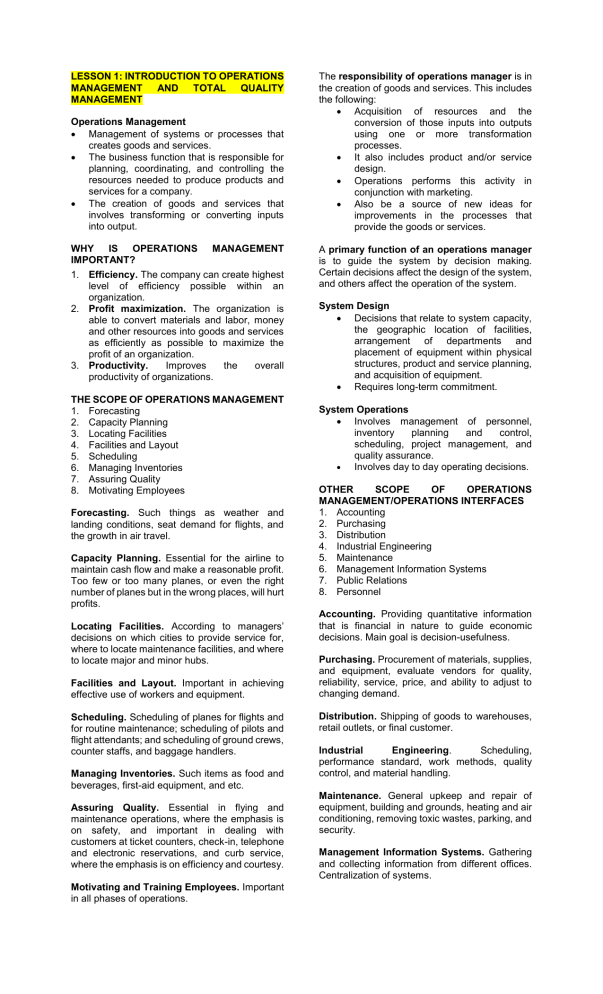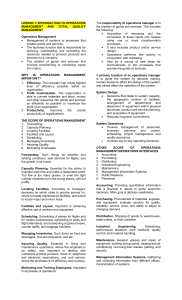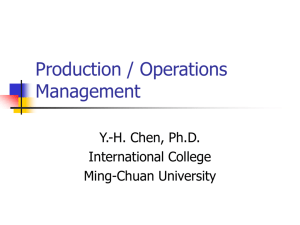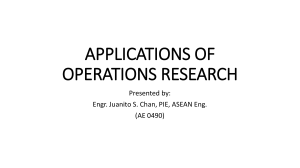
LESSON 1: INTRODUCTION TO OPERATIONS MANAGEMENT AND TOTAL QUALITY MANAGEMENT Operations Management Management of systems or processes that creates goods and services. The business function that is responsible for planning, coordinating, and controlling the resources needed to produce products and services for a company. The creation of goods and services that involves transforming or converting inputs into output. WHY IS OPERATIONS IMPORTANT? MANAGEMENT 1. Efficiency. The company can create highest level of efficiency possible within an organization. 2. Profit maximization. The organization is able to convert materials and labor, money and other resources into goods and services as efficiently as possible to maximize the profit of an organization. 3. Productivity. Improves the overall productivity of organizations. THE SCOPE OF OPERATIONS MANAGEMENT 1. Forecasting 2. Capacity Planning 3. Locating Facilities 4. Facilities and Layout 5. Scheduling 6. Managing Inventories 7. Assuring Quality 8. Motivating Employees Forecasting. Such things as weather and landing conditions, seat demand for flights, and the growth in air travel. Capacity Planning. Essential for the airline to maintain cash flow and make a reasonable profit. Too few or too many planes, or even the right number of planes but in the wrong places, will hurt profits. Locating Facilities. According to managers’ decisions on which cities to provide service for, where to locate maintenance facilities, and where to locate major and minor hubs. Facilities and Layout. Important in achieving effective use of workers and equipment. Scheduling. Scheduling of planes for flights and for routine maintenance; scheduling of pilots and flight attendants; and scheduling of ground crews, counter staffs, and baggage handlers. Managing Inventories. Such items as food and beverages, first-aid equipment, and etc. Assuring Quality. Essential in flying and maintenance operations, where the emphasis is on safety, and important in dealing with customers at ticket counters, check-in, telephone and electronic reservations, and curb service, where the emphasis is on efficiency and courtesy. Motivating and Training Employees. Important in all phases of operations. The responsibility of operations manager is in the creation of goods and services. This includes the following: Acquisition of resources and the conversion of those inputs into outputs using one or more transformation processes. It also includes product and/or service design. Operations performs this activity in conjunction with marketing. Also be a source of new ideas for improvements in the processes that provide the goods or services. A primary function of an operations manager is to guide the system by decision making. Certain decisions affect the design of the system, and others affect the operation of the system. System Design Decisions that relate to system capacity, the geographic location of facilities, arrangement of departments and placement of equipment within physical structures, product and service planning, and acquisition of equipment. Requires long-term commitment. System Operations Involves management of personnel, inventory planning and control, scheduling, project management, and quality assurance. Involves day to day operating decisions. OTHER SCOPE OF OPERATIONS MANAGEMENT/OPERATIONS INTERFACES 1. Accounting 2. Purchasing 3. Distribution 4. Industrial Engineering 5. Maintenance 6. Management Information Systems 7. Public Relations 8. Personnel Accounting. Providing quantitative information that is financial in nature to guide economic decisions. Main goal is decision-usefulness. Purchasing. Procurement of materials, supplies, and equipment, evaluate vendors for quality, reliability, service, price, and ability to adjust to changing demand. Distribution. Shipping of goods to warehouses, retail outlets, or final customer. Industrial Engineering. Scheduling, performance standard, work methods, quality control, and material handling. Maintenance. General upkeep and repair of equipment, building and grounds, heating and air conditioning, removing toxic wastes, parking, and security. Management Information Systems. Gathering and collecting information from different offices. Centralization of systems. Public Relations. Maintaining a good image for the business. Establishing the morale and integrity of the company. Personnel. Human resource office. Hiring, training, and procurement of manpower. Responsible for all the needs and benefits of its employees. BASIC FUNCTIONS MANAGEMENT OF OPERATIONS Operations management is important because every aspect of business affects or is affected by operations. Operations and sales are the two line functions in a business organization. THREE MAJOR FUNCTIONS OF OM 1. Operations 2. Marketing Lead Time Time necessary to deliver an action or producing a product. 3. Finance FINANCE AND OPERATIONS a. Budgeting Budgets must be periodically prepared to plan financial requirements. Budgets must sometimes be adjusted, and performance relative to a budget must be evaluated. b. Economic analysis of investment proposals Evaluation of alternative investments in plant and equipment requires inputs from both operations and finance people. c. Provision of funds The necessary funding of operations and the amount and timing of funding can be important and even critical when funds are tight. Careful planning can help avoid cashflow problems. MARKETING AND OPERATIONS a. Product development Marketing, design, and production must work closely together to successfully implement design changes and to develop and produce new products. b. Assessing competitors Marketing can provide valuable insight on what competitors are doing. c. Capacity Setting Marketing also can supply information on consumer preferences so that design will know the kinds of products and features needed; operations can supply information about capacities and judge the manufacturability of designs. d. Promotion Marketing’s focus is on selling and/or promoting the goods or services of an organization. e. Consumer Preferences Marketing is also responsible for assessing customer wants and needs, and for communicating those to operations people (short term) and to design people (long term). That is, operations needs information about demand over the short to intermediate term so that it can plan accordingly (e.g., purchase materials or schedule work), while design people need information that relates to improving current products and services and designing new ones. OPERATIONS, FINANCE, AND MARKETING Operations will also have advance warning if new equipment or skills will be needed for new products or services. Finance people should be included in these exchanges in order to provide information on what funds might be available (short term) and to learn what funds might be needed for new products or services (intermediate to long term). Marketing, operations, and finance must interface on product and process design, forecasting, setting realistic schedules, quality and quantity decisions, and keeping each other informed on the other’s strengths and weaknesses. People in every area of business need to appreciate the importance of managing and coordinating operations decisions that affect the supply chain and the matching of supply and demand, and how those decisions impact other functions in an organization. FEATURES OF OPERATIONS (Degree of Standardization) SYSTEMS Standardized Output There is a high degree of uniformity in goods or services. Goods - radios, televisions, computers, newspapers, canned foods, automobile tires, pens, and pencils Services - automatic car washes, televised newscasts, taped lectures, and commercial airline service. Customized Output The product or service is designed for a specific case or individual. Goods - eyeglasses, custom-fitted clothing, window glass (cut to order), and customized draperies Services - tailoring, taxi rides, and surgery. The Transformation Process Value Added INPUTS Land Labor Capital Information Transformation Conversion Process OUTPUTS Goods Services Feedback Feedback Control Value Added Used to describe the difference between the cost of inputs and the value or price of outputs. The greater the value added, the greater amount of funds available for some purposes. Examples of value added for organizations: o Highway construction, police protection non-profit and fire Examples of value added for profit organizations: o Research and development, investment in new facilities and equipment, worker salaries, incentives, and others. DIFFERENCE SERVICES BETWEEN GOODS AND Although goods and services often go hand in hand, there are some very basic differences between the two, differences that impact the management of the goods portion versus management of the service portion. There are also many similarities between the two. Production of goods results in a tangible output. Such as an automobile, eyeglasses, a golf ball, a refrigerator—anything that we can see or touch. It may take place in a factory, but it can occur elsewhere. For example, farming and restaurants produce non-manufactured goods. Delivery of service generally implies an act. A physician’s examination, TV and auto repair, lawn care, and the projection of a film in a theater are examples of services. POINTS OF COMPARISON 1. Degree of customer contact Many services involve a high degree of customer contact, although services such as Internet providers, utilities, and mail service do not. When there is a high degree of contact, the interaction between server and customer becomes a “moment of truth” that will be judged by the customer every time the service occurs. 2. Labor content of jobs Services often have a higher degree of labor content than manufacturing jobs do, although automated services are an exception. 3. Uniformity of inputs Service operations are often subject to a higher degree of variability of inputs. Each client, patient, customer, repair job, and so on presents a somewhat unique situation that requires assessment and flexibility. Conversely, manufacturing operations often have a greater ability to control the variability of inputs, which leads to more-uniform job requirements. 4. Quality assurance Quality assurance is usually more challenging for services due to the higher variation in input, and because delivery and consumption occur at the same time. Unlike manufacturing, which typically occurs away from the customer and allows mistakes that are identified to be corrected, services have less opportunity to avoid exposing the customer to mistakes. 5. Inventory Many services tend to involve less use of inventory than manufacturing operations, so the costs of having inventory on hand are lower than they are for manufacturing. However, unlike manufactured goods, services cannot be stored. Instead, they must be provided “on demand.” 6. Wages Manufacturing jobs are often well paid, and have less wage variation than service jobs, which can range from highly paid professional services to minimum-wage workers. 7. Ability to patent Product designs are often easier to patent than service designs, and some services cannot be patented, making them easier for competitors to copy. SIMILARITIES BETWEEN MANAGING THE PRODUCTION OF GOODS AND MANAGING SERVICES 1. Forecasting and capacity planning to match supply and demand. 2. Process management. 3. Managing variations. 4. Monitoring and controlling costs and productivity. 5. Supply chain management. 6. Location planning, inventory management, quality control, and scheduling. Characteristics Output Customer Contact Uniformity of Input Uniformity of Output Labor Content Measurement of Productivity Opportunity to correct quality problems before delivering to customers Goods Tangible Low High High Low Easy Service Intangible High Low Low High Difficult High Low THE HISTORICAL EVOLUTION OPERATIONS MANAGEMENT OF 1940 Operations research applications in warfare The Industrial Revolution Craft production system in which highly skilled workers use simple, flexible tools to produce small quantities of customized goods. 1947 Linear programming 1951 Commercial digital computers Automation Extensive development of quantitative tools Emphasis on manufacturing strategy Emphasis on quality, flexibility, time-based competition, lean production Scientific Management Mass production system in which lowerskilled workers use specialized machinery to produce high volumes of standardized goods. The scientific-management era brought widespread changes to the management of factories. The movement was spearheaded by the efficiency engineer and inventor Frederick Winslow Taylor, who is often referred to as the father of scientific management. A number of other pioneers also contributed heavily to this movement, including the following: Frank Gilbreth Was an industrial engineer who is often referred to as the father of motion study. He developed principles of motion economy that could be applied to incredibly small portions of a task. Henry Gantt Recognized the value of nonmonetary rewards to motivate workers, and developed a widely used system for scheduling, called Gantt charts. Harrington Emerson Applied Taylor's ideas to organization structure and encouraged the use of experts to improve organizational efficiency. He testified in a congressional hearing that railroads could save a million dollars a day by applying principles of scientific management. Henry Ford The great industrialist, employed scientific management techniques. Historical Summary Management Date 1776 1790 1911 1911 1912 1913 1915 1930 1935 of Contribution/Concept Division of labor Interchangeable parts Principles of scientific management Motion study; use of industrial psychology Chart for scheduling activities Moving assembly line Mathematical model for inventory management Howthorne studies on worker motivation Statistical procedures for sampling and quality control Operations Originator Adam Smith Eli Whitney Frederick W. Taylor Frank and Lilian Gilbreth Henry Gantt Henry Ford F. W. Harris Elton Mayo H.F. Dodge, H.G. Romig, W. Shewhart, L.H.C. Tippett 1950s 1960s 1975 1980s 1990s Internet, supply chains Operations research groups George Dantzig Sperry Univac Numerous Numerous W. Skinner Japanese manufacturers, especially Toyota and Taiichi Ohno Numerous TRENDS IN BUSINESS E-business Use of the Internet to transact business. Supply Chain A sequence of activities and organizations involved in producing and delivering a good or service.



